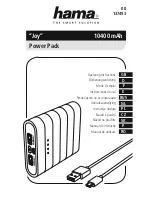
Call 800.879.8585 for Technical Support
BI-LEVEL CONTROL
The diagram to the right
shows how to configure
BZ-2xx to provide bi-level
lighting control with both
Automatic ON and Manual
ON features.
As shown, upon occupancy
detection load A turns
ON
automatically. To turn
ON
load B, the user must
press momentary switch
B. Both loads turn OFF
automatically when the
sensor time delay expires,
or manually using switch
A and B. If the sensor
input re-triggers within
30 seconds after the load
turns
OFF
, loads A and B
turn
ON
again. After 30
seconds expire with no
sensor input, you must
press the switch to turn
ON
load B.
LOW VOLTAGE OUTPUT OVERLOAD PROTECTION
The BZ-2xx contains built-in short circuit and thermal protection circuitry that
shuts down the +24 VDC output (low voltage red wire) to prevent permanent
damage to the power pack. Removing the excess load from the output restores
the BZ-2xx to proper operation. Connect the excess load to another power pack.
Output is current limited. As the load increases, the BZ output will reach its
model-specific maximum output current. Under these conditions, the output
voltage may appear less then the nominal 24-V output and the BZ will indicate
the overload conditions with a continuously blinking LED (as described in the LED
Indicator section). In extreme cases, such as a dead short, the output voltage will
appear near zero but will automatically return to normal operating conditions
once the excess load is removed.
+24VDC
Common
Red
White
Neut.
BZ-2xx
(A)
AUTO ON
Blue
Black
Red
Lighting
Load (A)
Black
Any 3-Wire
24VDC
Sensor
Hot
Red
Brown
Orange
Control
Low Voltage Wires
Red
White
Neut.
BZ-2xx
(B)
MANUAL ON
Blue
Black
Red
Lighting
Load (B)
Black
Hot
Red
Brown
Orange
Gr
ey
Momentary Switch (B)
Low Voltage Wires
Gr
ey
Momentary Switch (A)
Ground
Ground
NOTES:
• Orange, Brown, and Grey wires
are applicable only to the
BZ-250 and BZ-250-347.
• BZ-2xx power packs should be
grounded to ensure signal
integrity, not for safety ground.
Parallel interconnect for bi-level load control
from a single sensor with manual ON


























